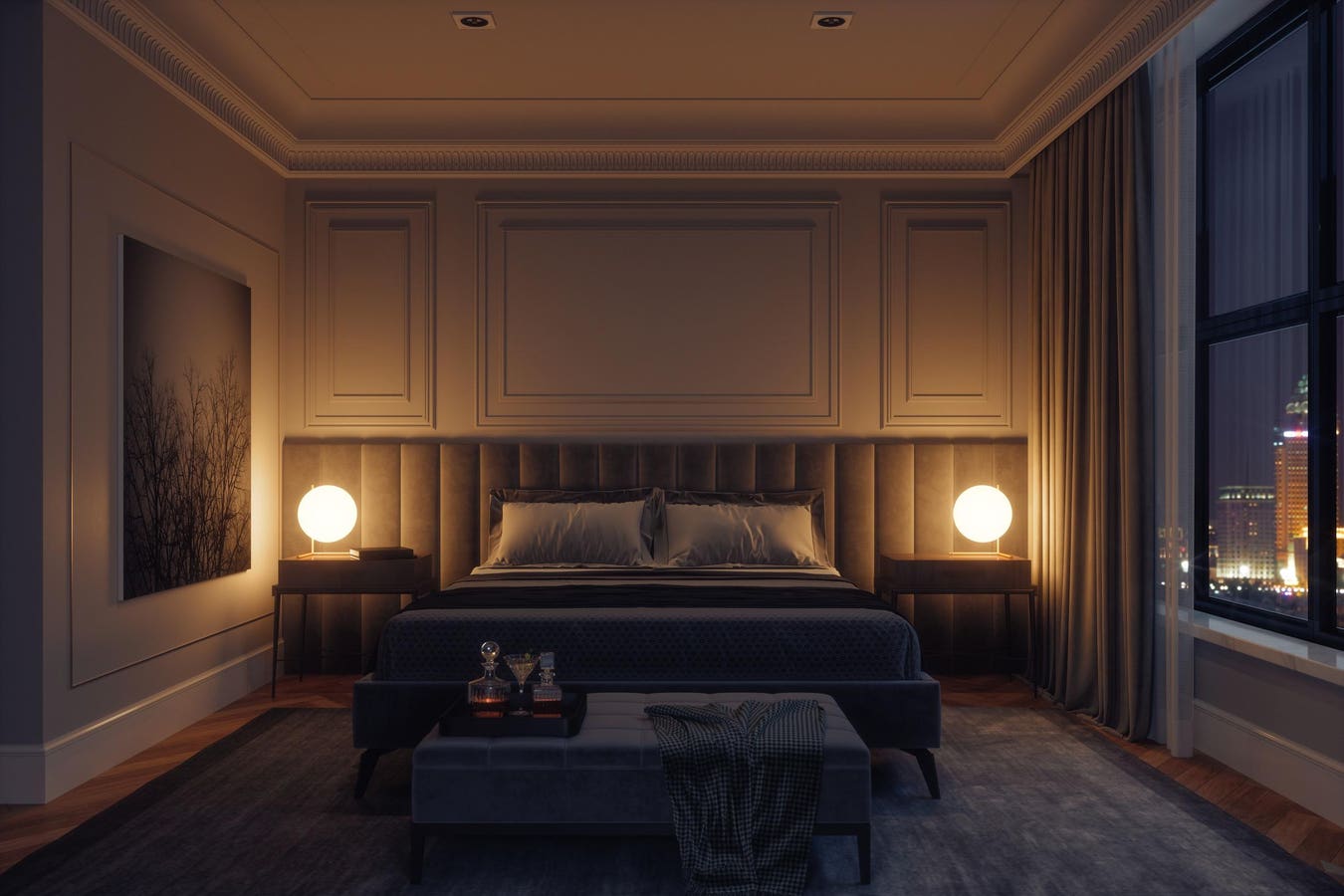While the world is constantly pulling at your attention, your bed can become your safe haven. Learn … More
In the whirlwind of daily life, you may often forget that your environment is in constant conversation with your emotions. You spend nearly a third of your life in bed, yet you might treat it as just a functional space.
However, your surroundings deeply influence your emotional state and your bed specifically has the potential to be a powerful form of self-care. That’s the idea behind “bedscaping,” the interior trend taking over bedrooms in 2025.
According to Pinterest’s 2025 predictions, searches for “boho bedroom” are up 65%, signaling a shift from clean minimalism to rich, textured and personal spaces. And there’s a good reason for it.
As Sarah Brown, interior stylist and founder of Dreamy Decor, explains, “We’re more emotionally connected to our homes than ever. More and more of my clients are styling their beds like they’re prepping a boutique hotel suite or a luxury wellness retreat.”
This shift isn’t just about decorating — it’s about how you feel in your space. Bedscaping invites you to be intentional, to see your bed as more than just a place to crash but as a reflection of your inner world. It’s a gentle reminder that your environment can nurture your emotional well-being
Here are two reasons you could benefit from bedscaping.
1. It Helps You Regulate Emotions Through Your Senses
Your bedroom, which you spend a significant portion of your day in, is a space that can influence your mood and stress levels more than you might realize. Designing your bedscape with a focus on sensory elements can have a direct effect on emotional regulation, helping you manage stress and find calm in a busy world.
This is more than just a trend. Research published in 2024 supports the idea that carefully designed spaces can be powerful tools for emotional healing. According to this study on healing spaces, engaging with the environment through your senses, through colors, textures, lighting and sounds around you, can have a profound effect on your emotions.
This research suggests that for people with mood disorders, such as anxiety or depression, thoughtfully designed spaces can support emotional regulation by promoting a sense of safety, calm and comfort.
The study identifies three critical elements that contribute to a healing environment:
- Safety. A space that feels secure and nurturing helps reduce emotional stress.
- Functionality. Spaces designed with purpose support emotional stability and well-being.
- Ambiance. The overall atmosphere, created through sensory stimulation, promotes emotional comfort.
By incorporating these elements into your own space, you can design a bedscape that actively contributes to your emotional regulation. Here’s how you can create a nurturing environment that aligns with these principles:
- Choose calming hues, like soft blues, greens or earth tones. These colors are known to reduce anxiety and promote relaxation. Conversely, bolder colors can invigorate the space, but should be used sparingly if you’re seeking calm.
- Opt for natural materials, like cotton, linen or velvet. These fabrics are not only visually pleasing but also offer comfort through touch. Layering different textures — like a soft duvet, cozy blankets and plush pillows — can enhance the tactile experience of your bedscape.
- Soft, warm lighting is key. Use bedside lamps, string lights or dimmable lights to create a soothing glow. Bright overhead lighting can be jarring, so create lighting that can adjust to your mood.
- Incorporating plants or elements of nature can evoke a sense of tranquility. Greenery has been shown to reduce stress, and it’s a simple way to bring a sense of healing energy into your space.
- Adding personal items, such as framed photos or meaningful decor, can ground you and create a space that feels uniquely yours. As Lizzie Russo from Nations Photo Lab says, “The best bedscapes include personal items that tell a story.”
Involving these sensory elements in your own bedroom design can help you create a sense of control and comfort — allowing your space to become an active participant in your emotional well-being.
2. It Naturally Promotes Sleep Hygiene
Sleep is fundamental to your well-being, and your bedroom environment plays a pivotal role in the quality of rest you achieve. A collaborative 2024 study by IKEA and the National Sleep Foundation (NSF) highlights that many individuals struggle with poor sleep hygiene.
Researchers found that more than 1 in 3 people say the design and setup of their bedroom significantly impacts how well they sleep. The National Sleep Foundation supports this, noting that your sleep environment plays a crucial role in helping your brain wind down and prepare for rest.
The NSF states that your sleep environment has a major impact on your ability to fall asleep and stay asleep. They recommend optimizing it by:
- Keeping the bedroom cool, quiet and dark.
- Using a comfortable mattress and pillows.
- Removing electronics to reduce distractions and blue light exposure.
- Making the space relaxing and soothing, which includes the feel and aesthetic of your bed and surroundings.
This is the essence of bedscaping — having a sanctuary of your own that reflects your personality while fostering a relaxing atmosphere. It’s all about personalizing and styling your bed to create a space that feels uniquely yours, not just for aesthetics, but for comfort and emotional well-being.
Creating a bedscape that promotes restful sleep doesn’t require a complete bedroom makeover — just thoughtful and intentional changes that make your space feel cozy and personal. Here are a few simple ways to bedscape for better sleep hygiene.
- Opt for soft, natural materials like cotton or linen for your sheets and duvet covers. These fabrics help regulate your body temperature and prevent overheating, making it easier to stay asleep throughout the night.
- Harsh overhead lights can keep your brain alert. Instead, opt for bedside lamps or string lights with warm tones. These mimic the natural light of sunset, encouraging your body to produce melatonin — the hormone that helps you sleep.
- Soft, soothing shades like dusty blues, sage greens and warm neutrals can help create a tranquil mood. These colors have a psychological effect that tells your brain it’s time to relax.
- A tidy, organized space helps calm your mind. Avoid piling clothes, gadgets or paperwork around your bed. A clean surface visually signals rest, not responsibility.
- Whether it’s a photo cushion from a trip, your favorite book on the nightstand or a scent you associate with calm — these small details ground your space in who you are, making your bed feel safe, familiar and soothing.
By intentionally designing a space that is personalized for you, you’re supporting your brain’s natural ability to unwind. With just a few intentional changes, your bed can become more than a place to sleep — it becomes a space that helps you truly rest and reset.
How To Curate A Bedscape That Speaks To You
Trends come and go, but bedscaping is a reminder that your space is meant to reflect who you are. It’s easy to fall into the trap of following what’s popular or what others consider aesthetic.
Instead of asking, “What’s aesthetically pleasing?” ask yourself, “What makes me feel comfortable and centered?” Don’t stress if your space doesn’t look like a magazine cover, since the goal is to create a sanctuary, not someone else’s vision of perfection.
Curating your space is an ongoing journey, and it should evolve with your life and preferences. Small, thoughtful details, like a calming scent from a candle or a photo that brings back happy memories, can greatly impact how you feel.
Even the smallest changes can create a ripple of positive energy that transforms your room, making it a space that supports your physical rest and mental and emotional health. That’s what truly matters.
Is your bed your sanctuary or a nightly battleground? Take this science-backed test to find out: Insomnia Severity Index








